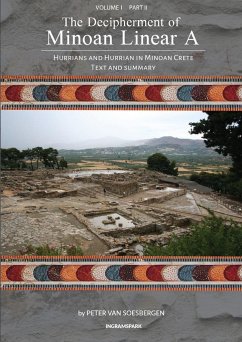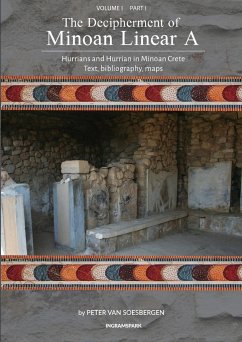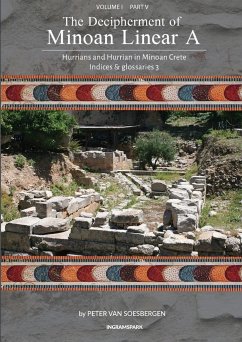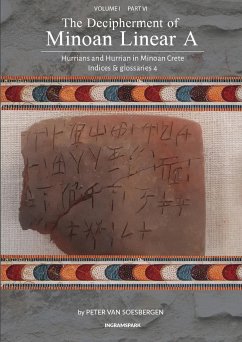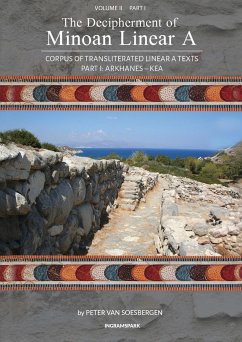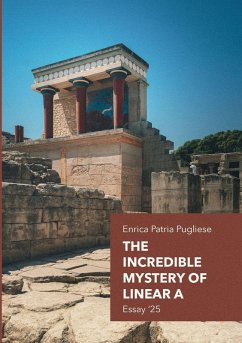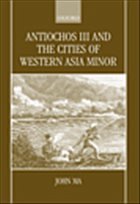
The Decipherment of Minoan Linear A, Volume I, Part III
Hurrians and Hurrian in Minoan Crete: Indices and glossary 1
Versandkostenfrei!
Versandfertig in 1-2 Wochen
66,99 €
inkl. MwSt.

PAYBACK Punkte
33 °P sammeln!
Overall there is a great unity of evidence visible in all Minoan palatial centres, villas and farm-houses. The administrative clay tablets with Linear A inscriptions offer mainly lists of personal names, consisting of Hurrian 'sentence names' and so-called 'one-word' names comparable with those from Near-Eastern and Anatolian centres. It is significant that we find both 'Old Hurrian' names and 'Mitanni-Hurrian' names in the Minoan centres as in the Near East and Anatolia. The 'Old Hurrian' names contain 'Old Hurrian' verbal forms and the 'Mitanni-Hurrian' show verbal forms that we know from th...
Overall there is a great unity of evidence visible in all Minoan palatial centres, villas and farm-houses. The administrative clay tablets with Linear A inscriptions offer mainly lists of personal names, consisting of Hurrian 'sentence names' and so-called 'one-word' names comparable with those from Near-Eastern and Anatolian centres. It is significant that we find both 'Old Hurrian' names and 'Mitanni-Hurrian' names in the Minoan centres as in the Near East and Anatolia. The 'Old Hurrian' names contain 'Old Hurrian' verbal forms and the 'Mitanni-Hurrian' show verbal forms that we know from the Türatta letter. It is clear that Linear B inherited many features from Linear A, especially the majority of syllabic and ideographic signs, signs for weights and measures and numeral signs (that show a decimal system). Linear A used, however, also many ligatures, of which some turn out to represent theonyms, notably NUBES+pi 100 (HT 33.4) = 'Cloud'+pi, which appears to be a rebus-like notation of the 'God of clouds' = Te¿ub+pi > Te¿uppi (genitive) 'of Te¿ub' followed by qe+pa3 = ¿e+pa3 100 (HT 33.4) = (Te¿ub's wife) ¿ebat, both followed by the high number of 100. Linear A has also signs for fractions, which Linear B seems to miss. In the Old Linear A grids Linear A sign 91 (showing graphic identity with Linear B sign *78) was still conventionally rendered as qe (labio-velar + e), but the actual phonetic value of Linear A 91 is ¿e (voiced velar fricative + e), which is the value of this sign in the new Linear A grid. The same applies to Linear A sign 62, that was formerly transliterated as qa (like the graphically identical Linear B sign *16 = *qa), but that is in the new Linear A grid ¿a. The author has proved with many confirmatory matches that Linear A sign 96 (and its variant sign 68) can be identified as ¿i. Among the many new identifications are some interesting ethnics: Linear A ku-re-96 (HT 39.2; HT 117b.1), transliterated as ku-re-¿i = ¿urr=e=¿i 'Hurrian', twice attested at Hagia Triada, and conventionally transliterated qa-ti-96 2 (ZA 14.2), interpreted as ¿atti¿i, ¿att=i=¿i, 'man/woman of the land ¿atti' = the Hurrian name for 'Hittite' occurring at Kato Zakro. There are many resemblances between Linear A and B, but also some differences. Most remarkable is the apparent lack of syllabic sequences describing products as we sometimes encounter in Linear B. The most likely reason is the very small size of the Linear A tablets, on which the Minoan scribes used ideograms that clearly and simply indicated vessels, commodities, animals, people, etc., whereas the Linear B scribes had enough space to add more detailed information to the ideograms. An exception is tablet HT 31 from Hagia Triada, where syllabic sequences are written on top of ideograms of vessels providing specific information on provenance and contents of the vessels.



